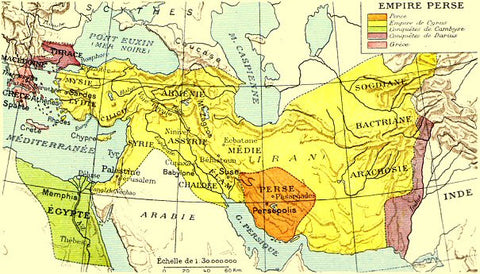The Persian Achaemenid Empire

The Empire _ Persian Achaemenid was one of the greatest empires of its time. An empire that began in 559 BC. JC following the liberation of the Persian people from the influence of the Medes, which collapsed in 330 BC. JC following the victory of Alexander the Great.
But what was this powerful empire , as vast as the future empire Roman, and having made Ancient Greece tremble?
But what was this powerful empire , as vast as the future empire Roman, and having made Ancient Greece tremble?

The origin of this empire is located in present-day Iran where two great peoples, with a similar language and culture, coexisted: The Medes and the Persians .
The Medes dominating the Persians in the 6th century BC. JC.
Wishing to free himself from the yoke of the Medes, Cyrus II , King of the Persians from 559 BC. JC and descendant of Achaemenes (who would be the supposed founder of this dynasty, and who gave the name of “ Achaemenids ”), instigated a revolt against the latter and overthrew them by seizing Media in 550 BC. JC.
This was followed by the beginnings of the development of this empire which was to become the largest empire of its time (covering approximately 7.5 million square meters).
The majority of Persians, it is worth pointing out, followed what we could name the first known monotheistic religion in the world : Zoroastrianism , from the name of its prophet and founder Zoroaster or Zarathustra , who revered Ahura Mazda .
The Medes dominating the Persians in the 6th century BC. JC.
Wishing to free himself from the yoke of the Medes, Cyrus II , King of the Persians from 559 BC. JC and descendant of Achaemenes (who would be the supposed founder of this dynasty, and who gave the name of “ Achaemenids ”), instigated a revolt against the latter and overthrew them by seizing Media in 550 BC. JC.
This was followed by the beginnings of the development of this empire which was to become the largest empire of its time (covering approximately 7.5 million square meters).
The majority of Persians, it is worth pointing out, followed what we could name the first known monotheistic religion in the world : Zoroastrianism , from the name of its prophet and founder Zoroaster or Zarathustra , who revered Ahura Mazda .

A religion that would have appeared in the second millennium BC. JC, but whose cult elements have been maintained until today in Iran, Afghanistan or even in Central Asia. Zoroastrian practitioners are estimated today at 190,000 people (mainly in Iran and India).
To return to the Persian Empire , following the conquest of the Medes, Cyrus II, as well as his descendants worked energetically to expand their empire .
Indeed, Cyrus II conquered in 539 BC. JC, the famous city of Babylon and then put an end to the Babylonian Empire .
His son, Cambyses II , meanwhile conquered Egypt , Lydia and Nubia in the 520s BC. JC.
It was then Darius I, known as Darius the Great, who attacked Greece and who failed at the famous battle of Marathon in 490 BC. JC, thus restricting the ambitions of his empire to Asia Minor, but marking the beginning of the Persian Wars between the Persian Empire and the Greeks.
At the death of Darius I, the Persian Achaemenid Empire was at the height of its power and expansion, and they would then retain the domination of territories ranging from the Indus to the Aegean Sea for nearly 2 centuries.
Xerxes I , the son of Darius I, will then do no less than his father. He again attacked Greece, but this time challenged the Greeks at the famous Battle of Thermopylae , then conquered Athens and burned down the Parthenon . The Greco-Persian Wars, which nevertheless ended in victory for the Greeks led by Athens and Sparta .
To return to the Persian Empire , following the conquest of the Medes, Cyrus II, as well as his descendants worked energetically to expand their empire .
Indeed, Cyrus II conquered in 539 BC. JC, the famous city of Babylon and then put an end to the Babylonian Empire .
His son, Cambyses II , meanwhile conquered Egypt , Lydia and Nubia in the 520s BC. JC.
It was then Darius I, known as Darius the Great, who attacked Greece and who failed at the famous battle of Marathon in 490 BC. JC, thus restricting the ambitions of his empire to Asia Minor, but marking the beginning of the Persian Wars between the Persian Empire and the Greeks.
At the death of Darius I, the Persian Achaemenid Empire was at the height of its power and expansion, and they would then retain the domination of territories ranging from the Indus to the Aegean Sea for nearly 2 centuries.
Xerxes I , the son of Darius I, will then do no less than his father. He again attacked Greece, but this time challenged the Greeks at the famous Battle of Thermopylae , then conquered Athens and burned down the Parthenon . The Greco-Persian Wars, which nevertheless ended in victory for the Greeks led by Athens and Sparta .

Many decades later—and having seen various wars, troubles, assassinations, and new kings—there followed the rise of Macedonia and the very famous Alexander the Great . Alexander the Great who conquered Persia and thus ended the Persian Achaemenid Empire , in 330 BC. JC.
The Persian Achaemenid Empire then gave way to the Persian Seleucid Empire , a dynasty descended from one of the generals of Alexander the Great.
The Persian Achaemenid Empire then gave way to the Persian Seleucid Empire , a dynasty descended from one of the generals of Alexander the Great.

The impressive tombs of the Achaemenid Kings, located at the archaeological site of Naghsh-e rostam, Iran.
